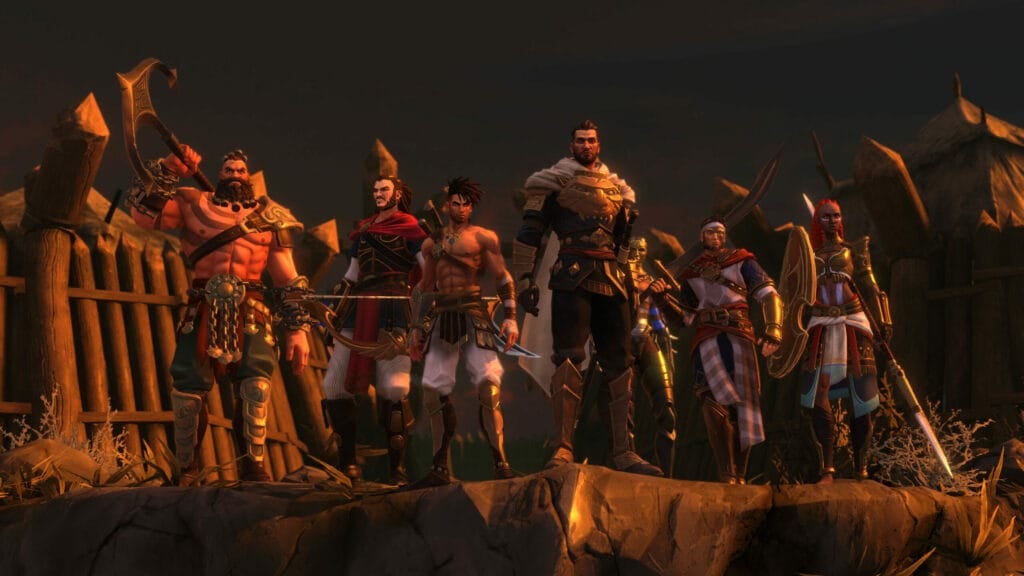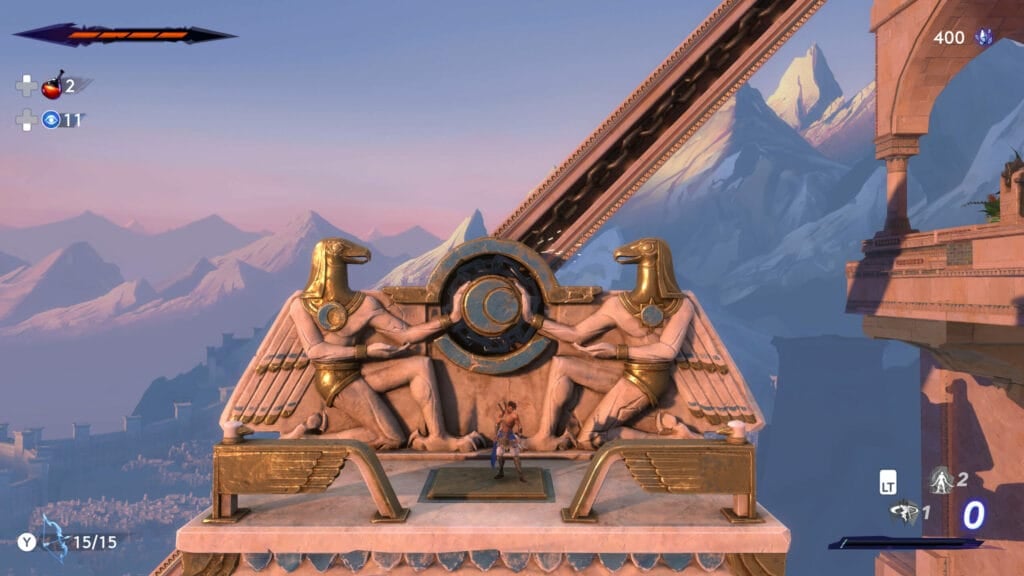While the long awaited Prince of Persia Sands of Time remake remains seemingly lost to the desert sands, Ubisoft have diligently been working on a brand-new game in the franchise. This time, it is neither a reboot, nor a remake. Rather, Prince of Persia The Lost Crown serves as a unique new franchise entry, cutting its own path through the arid wastes of nearly two decades of ignored legacy. Perhaps some franchises are best kept dormant; forced to slumber until the right people come along to give it the dedication it deserves? It certainly feels this way with Prince of Persia The Lost Crown.

Fans have been clamouring for a new entry in the Prince of Persia franchise for a very long time. Their wishes have arguably rung true, as the new title is a back-to-roots side-scrolling entry and not a third-person action adventure like Assassin’s Creed. Interestingly, therein lies the biggest problem Prince of Persia The Lost Crown has to face: it is decidedly not what the majority of current generation fans have asked for! Fortunately, the game more than proves its worth in a genre seemingly destined for the licence.
Prince of Persia The Lost Crown does away with the edge-lord narrative introduced in the latter instalments of the previous triple-A entries in the franchise, and replaces it with a Pixar-esque story about loyalty, betrayal, loss, and most importantly, triumph. Players take on the role of Sargon, a young and gifted warrior who is part of a band called The Immortals, some of Persia’s most skilled combatants. It tells the tale of how Sargon finally gains the Queen’s favour when he and his fellows put an end to a brutal war. Celebrations ensue and all seems well, but not for long.
Following the daring kidnapping of Ghassan, the Prince of Persia (roll credits), Sargon and the Immortals head for Mount Qaf (a legendary mountain ripped directly out of Middle Eastern mythology), where more than their skills in battle are tested. As expected from a Prince of Persia title, Prince of Persia The Lost Crown does, indeed, have a wonderful amount of wobbly, timey wimey stuff happening. In so doing, it allows players to enjoy every single moment of the 25 hours it takes to reach the end. While not entirely Earth-shattering, Ubisoft have done a commendable job at creating a neat and relatable narrative stretching time and space in a meaningful and, weirdly, logical way.


In truth, Prince of Persia The Lost Crown will be a tough start for any recent Prince of Persia fan. Overall gameplay takes the form of a 2.5D side scrolling Metroidvania. This means the game is an action platformer with puzzle elements and unlockable routes players need to return to later. However, it is not just one of those “New Wave” metroidvanias either — the game actually goes back to its own roots and plays homage to the original [and assumedly the first action platformer to exist] Prince of Persia (1989), and its 1993 MS-DOS sequel, Prince of Persia: The Shadow and the Flame. While it does away with many of the modern tropes featured in more recent Prince of Persia titles, it retains its thoughtfulness to both its fans, and the red and blue warrior fans know and love.
Prince of Persia The Lost Crown does an excellent job of easing players into the mechanics of the world. From introducing Sargon as an expert swordsman and acrobat, through to slowly introducing new abilities and gameplay mechanics as players make their way through the various zones of the overarching map, Mount Qaf, no one will feel like the game is pushing the various abilities down their throats. This is most unlike more modern Metroidvania titles, and a positive note. The ease of slotting in a new skill or ability when it is introduced also helps a lot. Most of the time players will “find” or “unlock” a new ability. When this happens, they will be shown how to use it by the game’s exceptional use of UI elements, but will also be told how they can only equip the ability once back at a Wak-Wak tree (the game’s version of checkpoints). The subsequent run back to one of these trees (or the decision to forge ahead instead) is not only the player’s sole prerogative, but also serves as a buffer for the player to think about the new skill and whether or not it will truly be needed in their next moments. Conversely, players will also find feathers containing parts of the Simurgh (a benevolent bird in Persian myth)’s powers. These come in the form of permanent upgrades completely altering the way players may look at and/or traverse the map.
Navigating the world is an equally important facet to get right, and Ubisoft have showcased their world building prowess once more. “Levels” are split into zones of varying shapes and sizes; where Sargon is required to chain acrobatic moves and combo, jumps and slides, in order to get from point A to B. Once Sargon acquires a bow, these platforming challenges become even more challenging, with the requirement to chain arrow shots mid-air. All levels slowly unlock in an organic manner, allowing players to study their layouts. Players who struggle to keep up with all the puzzles and/or possible progress locks need not fret either. The game introduces Memory Shards, a cool “memory” mechanic quite early on, which allows players to save and embed a visual snapshot of Sargon’s surroundings onto the game’s map. As with all Metroidvania games, backtracking is a natural part of the title, and Prince of Persia The Lost Crown has plenty to offer with a healthy amount of new ability and skill unlocks to keep players engaged at all times.

Beyond a great narrative arcing over gameplay and traversal, it must be said how Prince of Persia The Lost Crown still features a heck of a lot of combat. The game teaches players how to weave in and out of combat with ease; how to launch enemies, and keep them in the air, how to fell giants, and how to get rid of incessant floor-crawling enemies – all without breaking a sweat. Mastering combat, however, also means perfecting traversal! Once players get the hang of halting their fall with the bow, or swapping positions using one of the Simurgh’s powers found halfway through the game, both combat and traversal completely evolves into something wholly different than what the game first introduced to players. Furthermore, mastering combat also means having a much easier time with the various bosses and enemies encountered throughout Mount Qaf (the amount of unique enemies on offer is truly impressive).
Through all of the challenging timing and muscle memory the game imposes on players, it needs to be said how there is one major point of concern: “floatiness”. While personal skill level plays a major factor here, there is a growing concern over how floaty Sargon tends to be at times. While precision inputs are an absolute requirement for both platforming and combat, the game will seldom just not work as intended. Sometimes Sargon will take just a split second too long to perform a queued action, and sometimes his jumps will be more lazy than usual. Similarly, Sargon will sometimes just halt a combat chain or drop to the ground while performing a mid-air combo. With that said and to reiterate, personal skill level may be the important factor here; however it is something to take note of. There is one other small nitpick, an infuriating instance where the game ganks the player with as many mobs as it possibly can during a boss fight, leaving skill level at the door in favour of button mashing, but fortunately every other aspect of the game is an absolute wonder to behold.
Prince of Persia The Lost Crown is not some empty husk of a platformer either. The amount of collectibles and lore strewn throughout Mount Qaf is stellar to say the least. Opening the map will reveal how many tablets, items, and inscriptions can be found throughout any given level, while the world tells a tale of intermingling time and sand, flowing disproportionately and never quite like the river it is meant to be. People grow old right before Sargon’s eyes while multiple versions of the hero either lie dead, or vie for his powers. Friends become enemies, while enemies have their allegiances questioned and relationships are fostered throughout an otherwise war-weary world.
Furthermore, it must be said just how much of a gold standard Prince of Persia The Lost Crown is on a technical front. The game did not freeze or stutter once in 30 hours of gameplay! Loading is always quick, and Quick Resume on Xbox works flawlessly. Moreover, players can expect a smooth 4K60 on the Xbox Series X, with additional performance toggles for accessibility available at the very start of the game, or at any moment throughout.


From the way Ubisoft have crafted an immaculate world based on history and mythology, through to how the narrative plays into the gameplay, the talent at Ubisoft Montpeiller have done the franchise proud. Prince of Persia The Lost Crown emerges as a refreshing addition to the works of time shifting sands. While diverging from its recent third-person entries and returning to its roots as a side scrolling title, it masterfully aligns expectations from fans of both the licence, and the genre. The game captures the brilliance of the original Prince of Persia titles while conforming to modern mechanics in order to deliver a thoughtful, yet nostalgic experience. Prince of Persia The Lost Crown impresses with its impeccable world building, engaging lore, and compelling narrative; standing as a testament to how well looked after the franchise can be, when in the right hands.
Verdict:
EXCEPTIONAL
| PROS | CONS |
| Ubisoft are masters mythology and historical fiction | The controls can feel “floaty”. |
| Perfect genre for the Prince of Persia brand | |
| Gold standard for technical performance |
Title reviewed on Xbox Series X with code supplied by Ubisoft.
Review Methodology | Ethics Policy
Junior Editor at Vamers. From Superman to Ironman; Bill Rizer to Sam Fisher and everything in-between, Edward loves it all. He is a Bachelor of Arts student and English Major specialising in Language and Literature. He is an avid writer and casual social networker with a flare for all things tech related.









